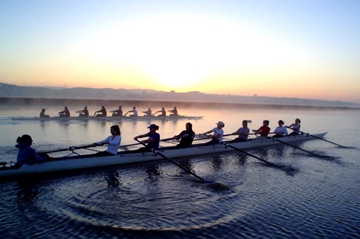Moving with the Spirit

Sermon for May 17, 2020
The Rev. Andria Skornik
A few years back I had the opportunity to join a rowing club through our YMCA, which meant starting with a weekend of training. As much as I and other newbies wanted to get out on the water, most of that training was spent on the shore covering the basics. But when the time finally came for us to get on the water, it wasn’t at all what we were expecting.
We’ve all seen the Olympic athletes who hop in their boats like it’s nothing and fly across the water with ease. Of course, as it turns out, it’s nothing like that. The vessels are incredibly lightweight, sensitive to the slightest touch, and really hard to keep steady -- way worse than any kayak or canoe I’d been in. And once you’ve ungracefully rolled yourself in the boat and think you might be steady, you add a few more inexperienced people in the boat and soon their lack of balance becomes a shared lack of balance, feeling like you will capsize any minute.
Then on top of all that, all of your first instincts of what to do to try to stay afloat or make the boat go faster actually make everything worse. When you tense up or try to counteract the tipping it throws things off more. Or when you get to actually rowing, if you try to force or muscle your way through the movement, you don’t go faster. It just throws everything off balance. Like you’re going to tip over but at a higher speed.
At the end of the training, I wasn’t sure rowing was in my future. But I kept going and had the experience to go out with more experienced rowers. And on one of those mornings on the water, as my partner and I were rowing -- back and forth and back and forth -- I felt myself in sync with the movement in a way I hadn’t before, and pretty soon we were gliding across the water. Smooth, light, and easy. And I was rowing better and faster than I had before, but with less exertion than in times past. It was such a great feeling.
I’m guessing you’ve experienced this, too. Maybe not in rowing, but most sports or arts or vocations have something like it. Like the mathematician who fervently works out a problem on the chalkboard, as in those scenes from A Beautiful Mind. Or the writer whose ideas are pouring onto the page, their fingers trying to keep up. Or the parent who masterfully redirects a tantrum into spontaneous play. When you’re in it, it’s like you’re immersed in the rhythm of what you’re doing and everything is moving in sync. Not only is it some of your best work, it’s one of the best feelings there is.
And I ask you to get an image of that, because I believe such experiences help us understand the Holy Spirit. Now, I know the Holy Spirit is one of things in our faith that some of us have struggled with, especially when it comes to the Trinity. After all, God the first person of the Trinity is revealed to us as Father and Mother, and we all have a good sense of what a parent is. Or Jesus is a person like us, who teaches us and models what it looks like to live in full Christ consciousness -- that’s fairly straightforward.
But then the Spirit is communicated to us through things like breath and wind and fire. Or movement even. In Trinitarian theology, the spirit is described as the flow of love between the Father and Son. Unlike God the Father and Son, God the Spirit isn’t personified in a way that makes it easy to know who the Spirit is and what our relationship with it is supposed to be like.
Our reading from John actually names this very difficulty when Jesus says how people are missing out on the spirit in their lives because they don’t see it or understand it. But in the same passage, Jesus says to the disciples you know the Spirit because it’s with you and in you. And in this same gospel, he tells Nicodemus that you know the Spirit in the same way you know the wind. You can’t see it, but you can feel it. And you can know where it is and where it’s going by the things it’s moving.
So then, perhaps rather than trying to have the right concept for the Holy Spirit, what if we were to identify it like the wind, and know it by what feels like when it’s moving in us through us around us. That’s a helpful thing, because, like my experience with rowing, once you know what it feels like -- what it’s like to be in that rhythm of the movement where things are working together and channeled in the right direction -- it’s easier to do it again and do those things that help you get into that space.
The Spirit is always moving. Like wind, or breath, water -- it’s always in motion -- always inviting us to enter its current (Rohr). Our part is then to do what we can to assist it and place ourselves in its movement. We do this whenever we love or serve; when we are gracious; when we accompany someone in their journey; when we respond with humility and understanding; when we stand with justice; when we lean towards creativity and possibility.
Richard Rohr describes it as staying in the Spirit’s positive force field. He says, “When people stand in this place and rest in love as their home base, they become quite usable by God,” and their cooperation with the spirit results in things like healings, forgiveness, answered prayers, and new freedom for those whom they include in the force field with them.”
I’m sure we can all think of people who operate from that space, and we’ve probably all felt the difference when we’re in that space. When the fruits of the Spirit -- of love, joy, peace and patience -- are present in our lives. And there’s a rightness to it -- like this is what we’re made for.
The challenge, however, is the many things that pull us out of that space. Like when we have too much going on; too much we’re having to carry; when there’s more conflict than we can cope with at once; or when we’re exposed to too much negativity. There are also people who have this effect on us -- those who are living from a place of woundedness and toxicity. It can be very hard not to get triggered by what they’re doing, and find ourselves sucked into that same place of negativity. And there are also ways that we resist or block the spirit. Like when we get anxious about things not going like we want and become obsessive and controlling. When we try to micromanage our situation rather than letting the spirit move us and take its lead. Or when our egos get too involved and the things we’re doing become all about us and not God’s bigger picture. It’s like in rowing, how when you tense up and try to force things it doesn’t get you anywhere. It just makes it worse. And the harder you push your own way, the closer you are to capsizing.
But on the other side of all this, if we can find that place of balance, recognize the spirit’s movement of love and aliveness, and align ourselves to its rhythm. In that place, where it’s pushing and pulling us, it’s like gliding across the water .We do some of our best work, don’t have to force things, and it’s one of the best feelings ever.
Recently, I’ve been seeing this happening in our church a lot. In the time since we’ve been physically distancing, people have been mobilizing so quickly. I probably don’t have to tell you this, but churches, like many institutions, are not known for making quick changes or working fast. There’s the joke that we do things at glacial speed. But in these past few months, there have been all of these new ministries or ways of doing ministry popping up all over at All Saints.
There are ministries helping us figure out how to celebrate each other’s life events while apart in unconventional but memorable ways. There’s a ministry to connect to connect us through a new directory that got set up in just a week. There’s the new food pantry that we’d been dreaming about for a while as something we cared about and wanted to do now literally coming together in just a few weeks. And it’s happening because people are stepping forward and taking on different pieces. Neighborhood partners have been donating, and our diocese just gave us a grant to help us scale up what we’re doing and thus the number of people we can help.
As I’ve talked to people involved in these different things, I hear them say, how it feels very real and right and right where our church should be. Or how they are feeling more invested than ever and it’s the thing they look forward to each week
If you want to know what the Holy Spirit looks like, that’s it. It is something to behold. And we need to remember what it feels like for the future. Because this is some of the best work we’ve ever done, and it feels pretty amazing.
In just a few weeks, it will be Pentecost, which is our big celebration of the Holy Spirit. Just as we prepare each year for Christmas or Easter, might we prepare for Pentecost by noticing what the Holy Spirit is doing in our lives right now? And allowing it. And assisting it. And finding ourselves in that place where we’re in sync with it, right where we’re supposed to be.
Influential Sources
Richard Rohr - https://cac.org/the-field-of-love-2019-11-07/, https://cac.org/compassion-not-sacrifice-2019-07-1...
